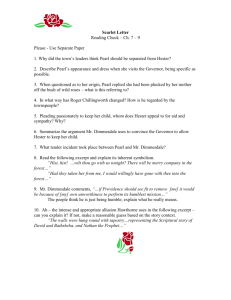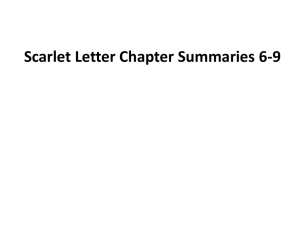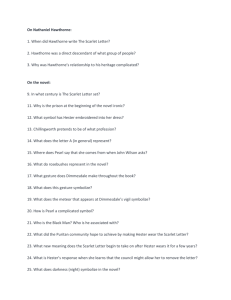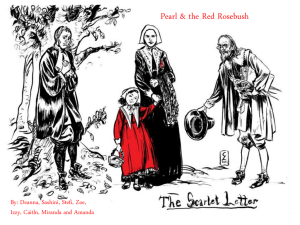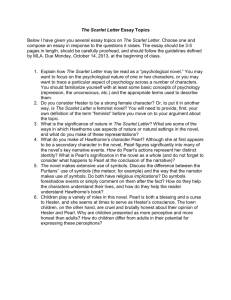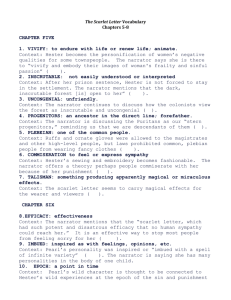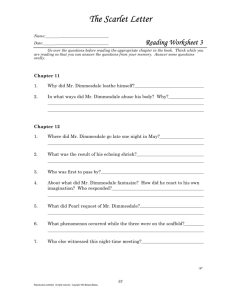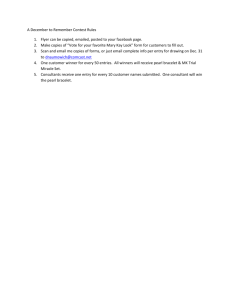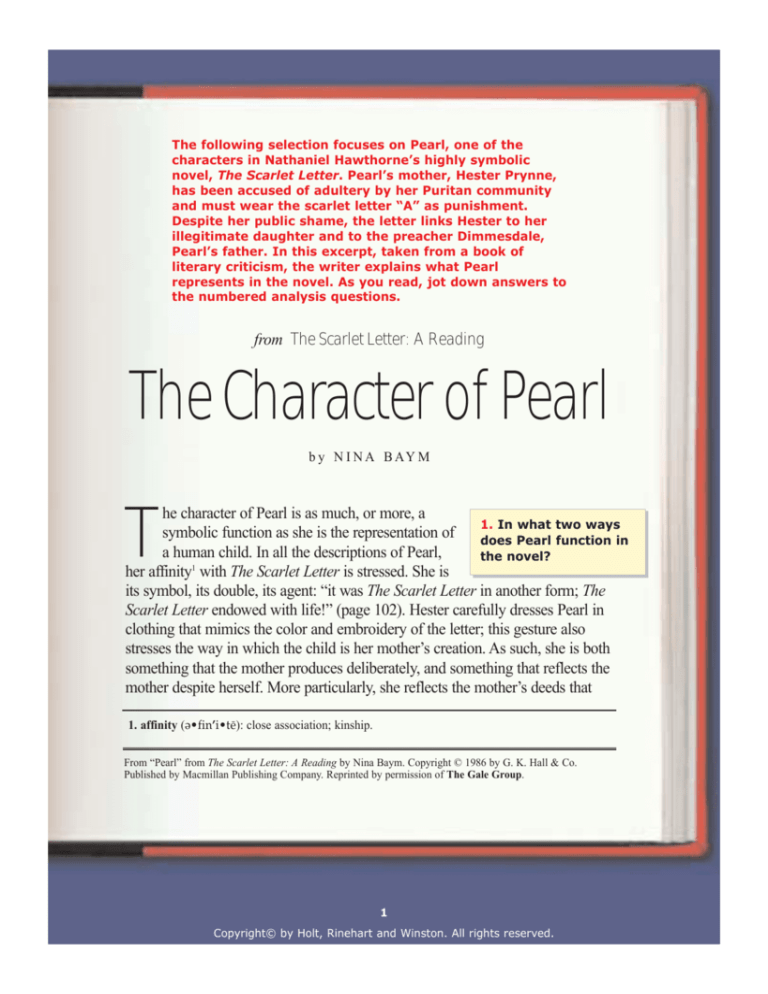
The following selection focuses on Pearl, one of the
characters in Nathaniel Hawthorne’s highly symbolic
novel, The Scarlet Letter. Pearl’s mother, Hester Prynne,
has been accused of adultery by her Puritan community
and must wear the scarlet letter “A” as punishment.
Despite her public shame, the letter links Hester to her
illegitimate daughter and to the preacher Dimmesdale,
Pearl’s father. In this excerpt, taken from a book of
literary criticism, the writer explains what Pearl
represents in the novel. As you read, jot down answers to
the numbered analysis questions.
from The Scarlet Letter: A Reading
The Character of Pearl
b y N I N A B AY M
he character of Pearl is as much, or more, a
1. In what two ways
symbolic function as she is the representation of
does Pearl function in
a human child. In all the descriptions of Pearl,
the novel?
her affinity1 with The Scarlet Letter is stressed. She is
its symbol, its double, its agent: “it was The Scarlet Letter in another form; The
Scarlet Letter endowed with life!” (page 102). Hester carefully dresses Pearl in
clothing that mimics the color and embroidery of the letter; this gesture also
stresses the way in which the child is her mother’s creation. As such, she is both
something that the mother produces deliberately, and something that reflects the
mother despite herself. More particularly, she reflects the mother’s deeds that
T
1. affinity (ß•fin’i•té): close association; kinship.
From “Pearl” from The Scarlet Letter: A Reading by Nina Baym. Copyright © 1986 by G. K. Hall & Co.
Published by Macmillan Publishing Company. Reprinted by permission of The Gale Group.
1
Copyright© by Holt, Rinehart and Winston. All rights reserved.
gave her life (her life is never attributed to her father).
In one sense, the Puritan sense, that deed is equal to a broken law. “The child
could not be made amenable2 to rules. In giving her existence, a great law had
been broken; and the result was a being, whose
2. Which of the writer’s
elements were perhaps beautiful and brilliant, but all in
main ideas do you think
disorder” (91). Hester recognizes in Pearl’s character
the quotations in this
“the welfare” of her own spirit during the months when paragraph support?
she was pregnant: “she could recognize her wild,
desperate, defiant mood, the flightiness of her temper, and even some of the very
cloud-shapes of gloom and despondency that had brooded in her heart” (91).
In another sense, however, the child is beauty and freedom and imagination
and all the other natural qualities that the Puritan system denies. Beautiful,
intelligent, perfectly shaped, vigorous, graceful, passionate, imaginative,
impulsive, capricious,3 creative, visionary: these are only a sampling of the
adjectives with which she is described. And these are all traits in Hester as well
as in Pearl. Such descriptions suggest that Pearl is not
3. How does the writer
an independent character so much as an abstraction of
explain the adjectives
elements of Hester’s character: a kind of “double,” or
Hawthorne chose to
“other self.” This means that character analysis of Pearl
describe Pearl?
is really analysis of Hester, and that the child’s
lawlessness shows how superficial Hester’s quiet and subservient public
demeanor is. And Hester’s great love for the child signifies in part her refusal to
disown her “sin” through a judgment that it was evil.
But Pearl is not simply a splitting off and intensifying of some aspects of
Hester’s character, a way of measuring Hester’s attitudes. Quite apart from
anything that Hester might intend consciously or unconsciously, Pearl seems to
have a special, original relation to the letter. She is not only the letter as Hester
might conceive it, but its agent in a scheme4 that is quite independent of her. If,
in Hester’s scheme, the child represents elements of defiant and lawless beauty,
2. amenable (ß•mé’nß•bßl): responsible, or able to be controlled.
3. capricious (kß•pré’Çßs): whimsical; given to sudden, impulsive behavior.
4. scheme (ském): overall plan; a system of definite arrangement.
2
Copyright© by Holt, Rinehart and Winston. All rights reserved.
in this other scheme the child represents a form of
4. What evidence does
conscience. It is her role to enforce the mother’s guilt
the writer provide to
as well as to represent her rebellion. She does this
prove that Pearl represimply by making it impossible for Hester to forget the sents a form of conletter. The letter is the first object that Pearl becomes
science?
aware of as a baby, and she keeps the letter firmly at
the center of Hester’s life by keeping it firmly in her infant regard. We see this
role as enforcer of the letter most clearly in the forest scene, the one and only
time that Hester throws the letter away. Oblivious to the mother’s resurgent5
youth and beauty and happiness, Pearl refuses to join her until the letter is
returned to its usual place. Only when she wears the letter is Hester her mother:
and this, alas, is a true perception on Pearl’s part. Should Hester repudiate6 the
letter, she will repudiate Pearl.
Much in the depiction of Pearl is realistic; she is not
5. What information
all symbol and allegory.7 Hawthorne used his journal
does the writer give
entries about his first child, Una, as sources for
that she’s learned
elements of his depiction of Pearl. Wildness, caprice,
from a source other
imaginativeness are all traits consistent with the nature
than the novel?
of a young child who is endowed with energy and
creativity and allowed a great deal of freedom. She lacks reference and
adaptation to the world into which she was born, Hester thinks (91); but kept
apart from society as Pearl is, any child would find it difficult to adapt.
If we could separate Pearl from her symbolic tasks
6. In what ways does
in the novel, we might take her simply as an unusual
the writer think that
(for its time), unidealized, and unsentimental
Pearl is a realistic
description of a real child. Her attraction to the letter is
character?
easily explained: The letter is colorful and shiny. Her
equation of it with her mother is likewise comprehensible: Pearl has never seen
Hester without it. And as for her behavior in the forest, Hester herself offers the
5. resurgent (ri•s¥r’jßnt): returning; rising again.
6. repudiate (ri•py‚’dé•át’): get rid of publicly; refuse relationship with.
7. allegory (al’ß•g¬r’é): a story in which characters or objects have symbolic meaning.
3
Copyright© by Holt, Rinehart and Winston. All rights reserved.
explanation that the child is jealous. Her reflecting of Hester’s moods may have
nothing mysterious about it: Spending so much time with her mother, being
completely dependent on her, and possessing an imaginative nature, Pearl would
naturally be keenly attuned to Hester, even more than the preoccupied mother
might be herself. Pearl’s extreme restlessness during the last scene in the
marketplace, the narrator says, was “played upon and vibrated with her mother’s
disquietude” (244).
However realistic she may be, there is no mistaking that at the end of the
book (when she kisses her father)8 Pearl becomes fully human for the first time.
A spell was broken. The great scene of grief, in which the wild infant bore
a part, had developed all her sympathies; and as her tears fell upon her
father’s cheek, they were the pledge that she would grow up amid human
joy and sorrow, not for ever do battle with the world, but be a woman in it.
Towards her mother, too, Pearl’s errand as a messenger of anguish was all
fulfilled. (256)
So Pearl has been the letter’s messenger (its angel, in the word’s original sense)
and the letter’s incarnation;9 and she has also been its victim. Her victimization
has consisted in being denied a reality of her own. At the very moment when she
becomes real, nevertheless—when her errand toward Hester is fulfilled—she
ceases to be a character in the story.10 Thus, the human character Pearl is not
really part of The Scarlet Letter, and the character in
7. How does the writer
the book is best thought of as a symbol and a function
explain the long quote
who is “naturalized” by being given a smattering of
above?
realistic traits.
8. her father: Dimmesdale, the preacher, who has never before publicly acknowledged he is Pearl's
father and who has privately suffered great shame for allowing Hester to bear all the punishment.
As Dimmesdale is dying, he calls out to Pearl for a sign of her affection (and forgiveness), and
she kisses him.
9.incarnation (in’kär•ná’shßn): given a human body as a living example of something.
10.she ceases . . . in the story: From this moment on Pearl does not appear in the novel as a
character. Her importance does not dim, but she is just not shown again.
4
Copyright© by Holt, Rinehart and Winston. All rights reserved.

